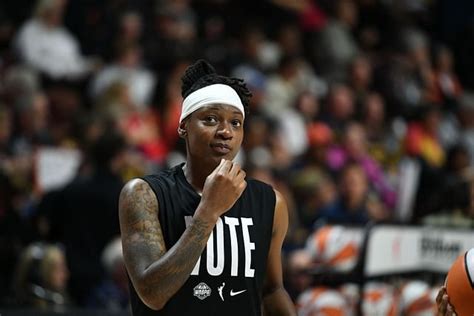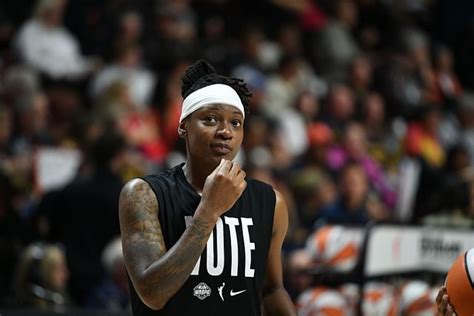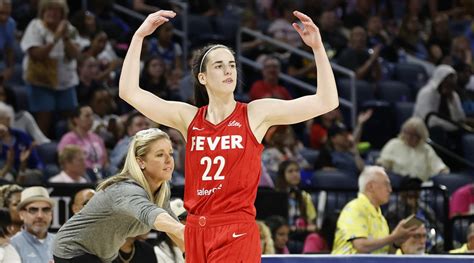
Caitlin Clark’s Indiana Fever teammate, Kristy Wallace, was ejected from Sunday’s game against the Seattle Storm and subsequently posted a cryptic “Truth Hurts” message on social media, adding intrigue to the Fever’s rocky start to the WNBA season.
INDIANAPOLIS – The Indiana Fever’s tumultuous season continued Sunday as guard Kristy Wallace was ejected during the Fever’s 103-88 loss to the Seattle Storm. Following the ejection, Wallace posted a cryptic message on social media that read, “Truth Hurts,” further fueling speculation about team dynamics and internal tensions within the struggling franchise. The timing of the post, immediately after her ejection, has led to widespread speculation about its intended target and the specific “truth” to which Wallace alludes.
Wallace’s ejection occurred in the second quarter of the game after she was assessed a Flagrant 2 foul for contact made against Seattle Storm guard Jewell Loyd. The foul was reviewed, and the ejection was confirmed, leading to Wallace’s early exit from the contest. At the time of the ejection, Wallace had played just under nine minutes, contributing two points and one assist.
The “Truth Hurts” post, shared on Wallace’s social media accounts, quickly gained traction among fans and media outlets, prompting intense debate about its meaning. Some speculate it was directed at the officiating, while others suggest it could be related to team strategy, coaching decisions, or even internal conflicts within the Fever organization. Adding to the intrigue, Wallace did not offer any further explanation or clarification regarding the post, leaving it open to interpretation.
This incident adds another layer of complexity to what has already been a challenging season for the Indiana Fever. The team, led by highly touted rookie Caitlin Clark, has struggled to find consistency and cohesion on the court, posting a losing record thus far. The Fever’s struggles have been magnified by the intense media scrutiny surrounding Clark’s transition to the professional level, placing additional pressure on the entire team.
The Fever acquired Kristy Wallace during the offseason to provide veteran leadership and stability to the guard position. Wallace, an Australian native, previously played in the WNBA for the Atlanta Dream and has extensive international experience. Her role on the team was envisioned as a steadying presence who could contribute on both ends of the floor and help guide the younger players, including Clark. However, her ejection and subsequent social media post have now raised questions about her fit within the team dynamic and her long-term future with the Fever.
The Indiana Fever organization has not yet released an official statement regarding Wallace’s ejection or her social media post. The team’s coaching staff and management are likely addressing the situation internally to assess the impact on team morale and chemistry. This incident comes at a critical juncture for the Fever, as they are striving to build a competitive team around Caitlin Clark and establish a winning culture.
Contextual Background
The Indiana Fever entered the 2024 WNBA season with heightened expectations, largely fueled by the arrival of Caitlin Clark, the NCAA’s all-time leading scorer. Clark’s presence has brought unprecedented attention to the franchise, with record-breaking attendance figures and television viewership numbers. However, the increased spotlight has also intensified the pressure on the Fever to perform at a high level and quickly develop into a contender.
Prior to the season, the Fever made several roster moves to bolster their lineup and surround Clark with experienced players. The acquisition of Kristy Wallace was one such move, aimed at adding depth and leadership to the guard rotation. Wallace’s previous WNBA experience and international success were seen as valuable assets that could complement Clark’s skillset and help the team navigate the challenges of the WNBA season.
The Fever’s early-season struggles have exposed some of the challenges facing the team. Clark, while showing flashes of brilliance, has also faced the expected growing pains of adjusting to the physicality and speed of the professional game. The team has also struggled with defensive consistency and rebounding, leading to several lopsided losses.
The pressure to win and the intense media scrutiny have created a tense environment around the team. Rumors of internal friction and disagreements have surfaced, although the team has largely attempted to project a united front. Wallace’s social media post, however, has reignited those concerns and raised questions about the overall state of the Fever’s team dynamics.
Wallace’s Career and Role on the Fever
Kristy Wallace, a 28-year-old guard from Australia, has been a professional basketball player for several years. She began her WNBA career with the Atlanta Dream in 2018 and has also played professionally in Australia and Europe. Wallace is known for her defensive tenacity, playmaking ability, and veteran leadership.
The Fever signed Wallace as a free agent during the offseason, hoping that she could provide a stabilizing presence in the backcourt. Coach Christie Sides highlighted Wallace’s experience and basketball IQ as key attributes that would benefit the team. Wallace was expected to contribute on both ends of the floor, providing scoring, playmaking, and defensive intensity off the bench.
In the early part of the season, Wallace has played a limited role for the Fever, averaging around 15 minutes per game. She has shown flashes of her potential, but has also struggled to find consistency in her performance. Her ejection against the Seattle Storm was a setback, and it remains to be seen how the team will respond to the incident.
The Flagrant 2 Foul and Ejection
The specific play that led to Wallace’s ejection occurred in the second quarter of the game against the Storm. Wallace was defending Jewell Loyd on a drive to the basket when she made contact with Loyd’s head. The referees initially called a foul on the play, but after reviewing the replay, they upgraded the foul to a Flagrant 2, which automatically results in an ejection.
A Flagrant 2 foul is defined as “unnecessary and excessive contact committed by a player against an opponent.” The severity of the contact and the potential for injury are factors considered when determining whether a foul warrants a Flagrant 2 designation. In Wallace’s case, the referees determined that her contact with Loyd’s head met the criteria for a Flagrant 2, leading to her ejection.
Wallace appeared surprised and frustrated by the ejection, but she did not argue with the referees. She left the court and headed to the locker room, while her teammates attempted to regroup and continue the game without her.
The “Truth Hurts” Post and its Implications
Wallace’s social media post, containing the simple phrase “Truth Hurts,” immediately sparked speculation and debate among fans and media outlets. The timing of the post, coming immediately after her ejection, strongly suggested that it was related to the events of the game. However, the lack of further explanation from Wallace left the interpretation open to a wide range of possibilities.
Some speculated that the post was directed at the officiating, suggesting that Wallace felt she was unfairly ejected from the game. Others suggested that it could be related to team strategy or coaching decisions, implying that Wallace disagreed with the way the team was being managed. Still others suggested that it could be a reflection of internal conflicts within the team, perhaps stemming from the pressure to perform and the challenges of integrating Caitlin Clark into the lineup.
The lack of clarity surrounding the post has only fueled the speculation and intensified the focus on the Fever’s internal dynamics. The incident has added another layer of pressure on the team as they attempt to navigate their early-season struggles and build a cohesive unit.
Team Dynamics and Caitlin Clark’s Impact
Caitlin Clark’s arrival in Indiana has undoubtedly transformed the Fever organization. Her immense talent and popularity have brought unprecedented attention to the team, both positive and negative. While Clark has shown flashes of brilliance, she has also faced the challenges of adjusting to the WNBA’s physicality, speed, and defensive intensity.
The Fever’s coaching staff and veteran players have emphasized the importance of patience and support as Clark develops her game and adapts to the professional level. However, the pressure to win and the constant media scrutiny have created a challenging environment for the entire team.
The team dynamics have been further complicated by the influx of new players and the need to integrate them quickly into the existing system. Building chemistry and cohesion takes time, and the Fever have not yet found the right formula to maximize their potential.
Wallace’s social media post has raised questions about the team’s internal harmony and the potential for conflicts to arise under pressure. It remains to be seen how the team will address these concerns and whether they can overcome the challenges to build a winning culture.
The Fever’s Response and Future Outlook
The Indiana Fever organization has not yet issued an official statement regarding Wallace’s ejection or her social media post. It is likely that the team is addressing the situation internally, assessing the impact on team morale and chemistry.
Coach Christie Sides and the Fever’s management team face a difficult task in navigating this situation. They must address Wallace’s concerns, maintain team unity, and continue to develop a winning strategy on the court.
The Fever’s future success hinges on their ability to integrate Caitlin Clark into the lineup, build a cohesive team dynamic, and improve their defensive consistency. The challenges are significant, but the potential is also there for the Fever to become a competitive force in the WNBA.
The Wallace incident serves as a reminder of the pressures and challenges that come with playing professional sports. It is a test of the team’s resilience and their ability to overcome adversity. The way the Fever responds to this situation will be a key indicator of their long-term success.
The team’s next games will be closely watched as fans and analysts look for clues about the team’s internal dynamics and their ability to bounce back from this latest setback. The pressure is on for the Fever to demonstrate that they can overcome the challenges and live up to the high expectations that have been placed upon them.
Expert Analysis and Opinions
WNBA analysts and commentators have weighed in on the Wallace situation, offering their perspectives on the potential implications for the Fever.
Some analysts have suggested that Wallace’s post could be a sign of deeper issues within the team, pointing to the pressure and scrutiny that the players are facing. Others have downplayed the incident, suggesting that it is simply a momentary frustration that will be resolved internally.
“This is a young team under a lot of pressure,” said ESPN analyst Rebecca Lobo. “They’re still trying to figure things out, and there are bound to be some bumps in the road. The key is how they respond to these challenges.”
Another analyst, LaChina Robinson of NBA TV, emphasized the importance of communication and leadership within the team. “The Fever need to have open and honest conversations to address any underlying issues,” Robinson said. “It’s up to the veteran players and the coaching staff to create a supportive environment where everyone feels comfortable expressing their concerns.”
The opinions of these experts highlight the complexity of the situation and the need for the Fever to address the issue with sensitivity and transparency. The team’s response will be crucial in shaping their future success.
The Impact on WNBA Viewership and Popularity
The Caitlin Clark effect has had a significant impact on WNBA viewership and popularity. Games featuring the Fever have drawn record-breaking television audiences, and attendance figures have soared.
However, the increased attention has also brought added pressure and scrutiny to the team. The players are constantly under the microscope, and any internal issues or conflicts are quickly amplified by the media.
The Wallace incident is a prime example of this phenomenon. The social media post quickly went viral, generating widespread discussion and debate. While the incident itself may be relatively minor, the attention it has received underscores the increased spotlight on the WNBA and its players.
The WNBA is hoping that the increased popularity will translate into long-term growth and sustainability. However, the league must also address the challenges that come with increased attention, such as managing player expectations, maintaining team unity, and dealing with media scrutiny.
The Future of Kristy Wallace with the Fever
The future of Kristy Wallace with the Indiana Fever remains uncertain. The team has not yet announced any disciplinary action in response to her ejection or her social media post.
It is possible that Wallace will face a suspension or fine from the league. The Fever could also choose to release her from the team, although that seems unlikely at this point.
The most likely scenario is that Wallace will remain with the team, but her role and playing time could be affected. The Fever will need to assess her attitude and commitment to the team before making any long-term decisions.
Wallace’s performance in future games will also be a key factor in determining her future with the Fever. She will need to demonstrate that she can put the incident behind her and contribute positively to the team’s success.
Conclusion
Kristy Wallace’s ejection and subsequent social media post have added another layer of intrigue to the Indiana Fever’s already eventful season. The incident has raised questions about team dynamics, internal tensions, and the overall impact of Caitlin Clark’s arrival on the franchise.
The Fever’s response to this situation will be crucial in shaping their future success. The team must address Wallace’s concerns, maintain team unity, and continue to develop a winning strategy on the court.
The challenges are significant, but the potential is also there for the Fever to become a competitive force in the WNBA. The team’s ability to overcome adversity and build a cohesive unit will be key to their long-term success. The WNBA world will be watching closely to see how the Fever navigates this latest challenge and whether they can live up to the high expectations that have been placed upon them.
Frequently Asked Questions (FAQ)
1. What exactly happened with Kristy Wallace and the Indiana Fever?
Kristy Wallace, a guard for the Indiana Fever, was ejected from their game against the Seattle Storm after receiving a Flagrant 2 foul. Following the ejection, Wallace posted a cryptic message on social media that read, “Truth Hurts,” leading to speculation about its meaning and potential implications for the team.
2. Why was Kristy Wallace ejected from the game?
Wallace was ejected after committing a Flagrant 2 foul against Seattle Storm guard Jewell Loyd. A Flagrant 2 foul is defined as unnecessary and excessive contact against an opponent. The referees reviewed the play and determined that Wallace’s contact met the criteria for a Flagrant 2, resulting in her automatic ejection.
3. What does Kristy Wallace’s “Truth Hurts” post mean?
The meaning of Wallace’s post is open to interpretation, as she has not provided any clarification. Speculation ranges from dissatisfaction with the officiating of the game to potential internal conflicts within the Fever organization related to coaching decisions, team strategy, or the pressure surrounding Caitlin Clark’s arrival.
4. How is the Indiana Fever organization responding to the situation?
As of now, the Indiana Fever organization has not released an official statement regarding Wallace’s ejection or her social media post. It is presumed that the coaching staff and management are addressing the situation internally to assess its impact on team morale and chemistry.
5. What does this incident mean for the Indiana Fever’s future?
This incident adds complexity to an already challenging season for the Fever. It raises questions about team dynamics and cohesion, particularly given the pressure surrounding Caitlin Clark’s arrival and the team’s early struggles. The team’s ability to address any underlying issues and maintain unity will be critical in determining their future success.
6. Has Kristy Wallace faced disciplinary actions from the league or team?
As of the latest reports, neither the WNBA nor the Indiana Fever have announced any specific disciplinary actions against Kristy Wallace beyond the automatic ejection from the game. It remains to be seen if further penalties, such as a suspension or fine, will be imposed after internal review.
7. What is the definition of a Flagrant 2 foul in the WNBA?
A Flagrant 2 foul in the WNBA is defined as “unnecessary and excessive contact committed by a player against an opponent.” The severity of the contact and the potential for injury are key factors considered by referees when determining whether a foul warrants a Flagrant 2 designation. It results in immediate ejection of the player committing the foul.
8. How has Caitlin Clark’s presence affected the Indiana Fever?
Caitlin Clark’s arrival has significantly increased the attention on the Indiana Fever, leading to record-breaking attendance and television viewership. While her presence has generated excitement, it has also intensified the pressure on the team to perform well and has placed a greater spotlight on both successes and any challenges they face.
9. What is Kristy Wallace’s background and role on the Indiana Fever?
Kristy Wallace is a 28-year-old guard from Australia who has played in the WNBA and professionally in Australia and Europe. She’s known for her defensive tenacity, playmaking ability, and veteran leadership. The Fever signed Wallace as a free agent, hoping she could provide a stabilizing presence in the backcourt, but has struggled to gain significant minutes in the regular rotation.
10. How can the Indiana Fever improve their team dynamics amid these challenges?
Experts suggest open and honest communication within the team, strong leadership from veteran players and the coaching staff, and a supportive environment where players feel comfortable expressing their concerns. Building chemistry and cohesion takes time, and the Fever will need to find the right formula to maximize their potential.
11. What has been the reaction from WNBA analysts to Wallace’s post and the ejection? WNBA analysts have offered various interpretations. Some believe it indicates deeper problems within the team due to pressure and scrutiny, while others view it as a fleeting moment of frustration. Most agree on the need for effective communication and leadership to navigate these challenges.
12. What are some potential reasons for Wallace’s cryptic message? Potential reasons range from discontent with officiating decisions to disagreements over team strategy or even internal conflicts. Without further clarification from Wallace, the exact meaning remains speculative.
13. Has the WNBA commented on the increase in scrutiny and pressure on teams like the Fever due to star players like Clark? The WNBA acknowledges the increased attention brought by players like Clark and recognizes the need to manage the associated challenges, including player expectations, team unity, and media scrutiny, to ensure sustainable growth.
14. What specific roster moves did the Fever make to support Caitlin Clark besides signing Wallace? While the article doesn’t detail every roster move, it mentions that the Fever made moves to surround Clark with experienced players. These moves aim to provide a balanced team that can support and complement Clark’s abilities effectively. Further details would require looking into official team announcements.
15. Are there any indications of tension between Clark and other players on the team? There are no explicit indications of tension between Clark and other players within the article itself. The article primarily focuses on the situation involving Wallace and the speculation it has triggered. Rumors or indications of tension would require other sources to confirm.
16. How has the pressure to win influenced the Indiana Fever’s performance and team environment? The pressure to win, coupled with intense media scrutiny, has created a challenging environment for the team, potentially contributing to internal friction and complicating the integration of new players into the existing system.
17. What options does the Fever’s coaching staff have to address the Wallace situation and maintain team morale? The coaching staff can engage in direct communication with Wallace to understand her concerns, facilitate open discussions within the team to address any underlying issues, and reinforce team values and goals to maintain unity and focus.
18. How does this situation compare to other instances of team tension in the WNBA? While the specifics differ, instances of team tension are not uncommon in professional sports. This situation highlights the ongoing challenges of managing diverse personalities, high expectations, and the intense pressures of competitive environments within the WNBA. Specific comparisons would require analyzing other case studies of WNBA teams facing similar issues.
19. In what areas do experts feel the Indiana Fever need to improve to become more competitive? Experts highlight the need for improved defensive consistency, more effective rebounding, and a greater ability to integrate Clark effectively into the lineup while fostering strong team chemistry and cohesion.
20. What can be done to better manage the expectations surrounding rookie players like Caitlin Clark? Managing expectations requires a multi-faceted approach involving clear communication from the coaching staff and veteran players, realistic assessments of performance and progress, and a supportive environment that acknowledges both successes and areas for growth. Additionally, managing media and fan expectations is crucial.
21. Are there other veteran players on the Fever who can step up and help lead the team in this situation?
The article mentions that the Fever sought to add veteran leadership, but it doesn’t specify other veterans who might step up. Identifying those leaders would require further team information.
22. Has Jewell Loyd, the player involved in the Flagrant 2 foul, commented on the situation?
The article does not mention any comments from Jewell Loyd regarding the incident.
23. How frequently are Flagrant 2 fouls called in the WNBA, and is Wallace known for aggressive play?
The frequency of Flagrant 2 fouls can vary, and the article does not provide enough information to determine how common they are. It also doesn’t mention whether Wallace has a reputation for aggressive play. This would require further research into WNBA statistics and player profiles.
24. How might Wallace’s social media following or platform influence the reach and interpretation of her post?
Wallace’s social media presence could amplify the reach of her message, contributing to broader speculation and attention. The extent of this influence would depend on her follower count and engagement levels.
25. What strategies might the Fever use to shield Caitlin Clark from some of the external pressure and scrutiny?
The Fever could implement strategies such as limiting Clark’s media availability, providing her with experienced mentors within the team, and fostering a supportive environment that prioritizes her development and well-being over immediate performance expectations.









